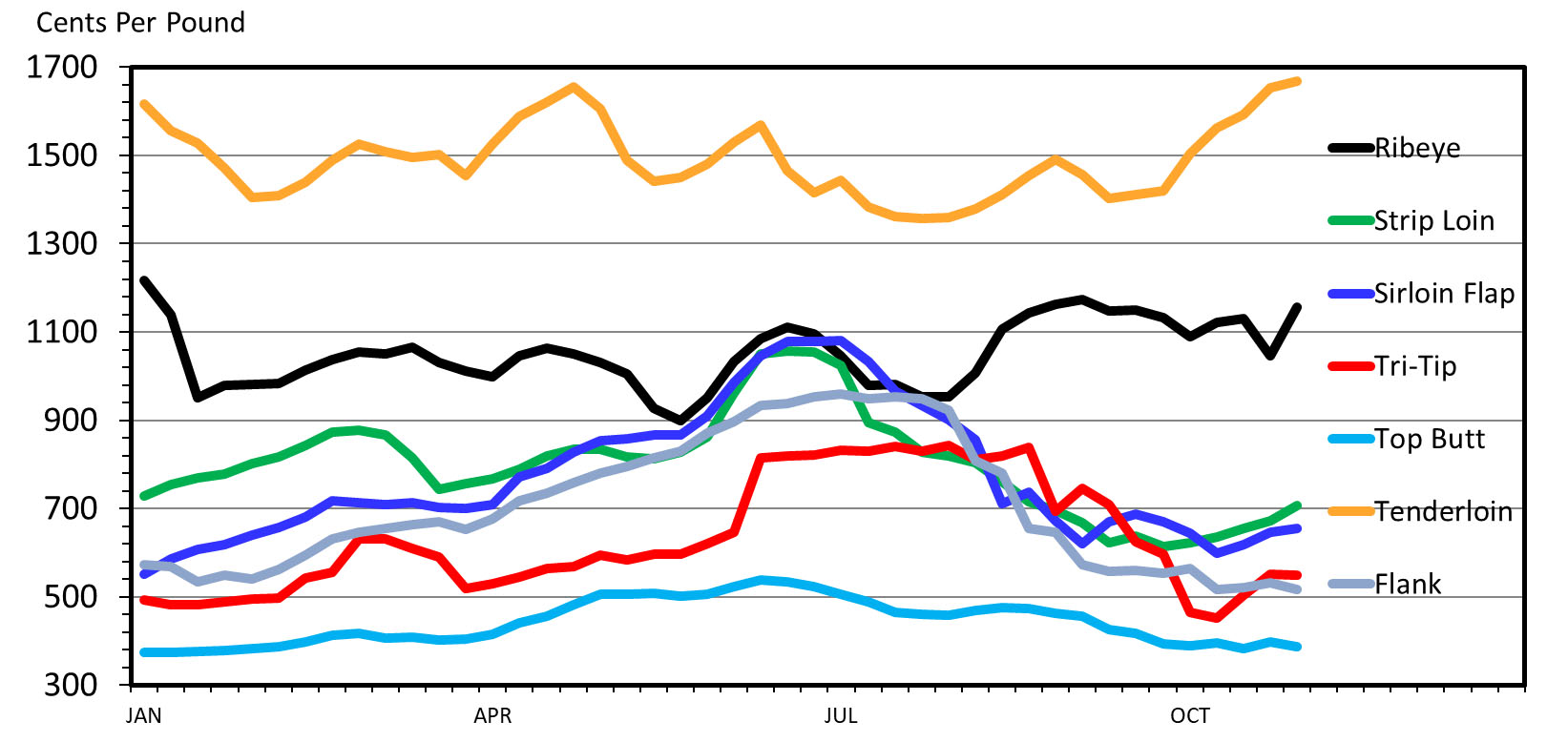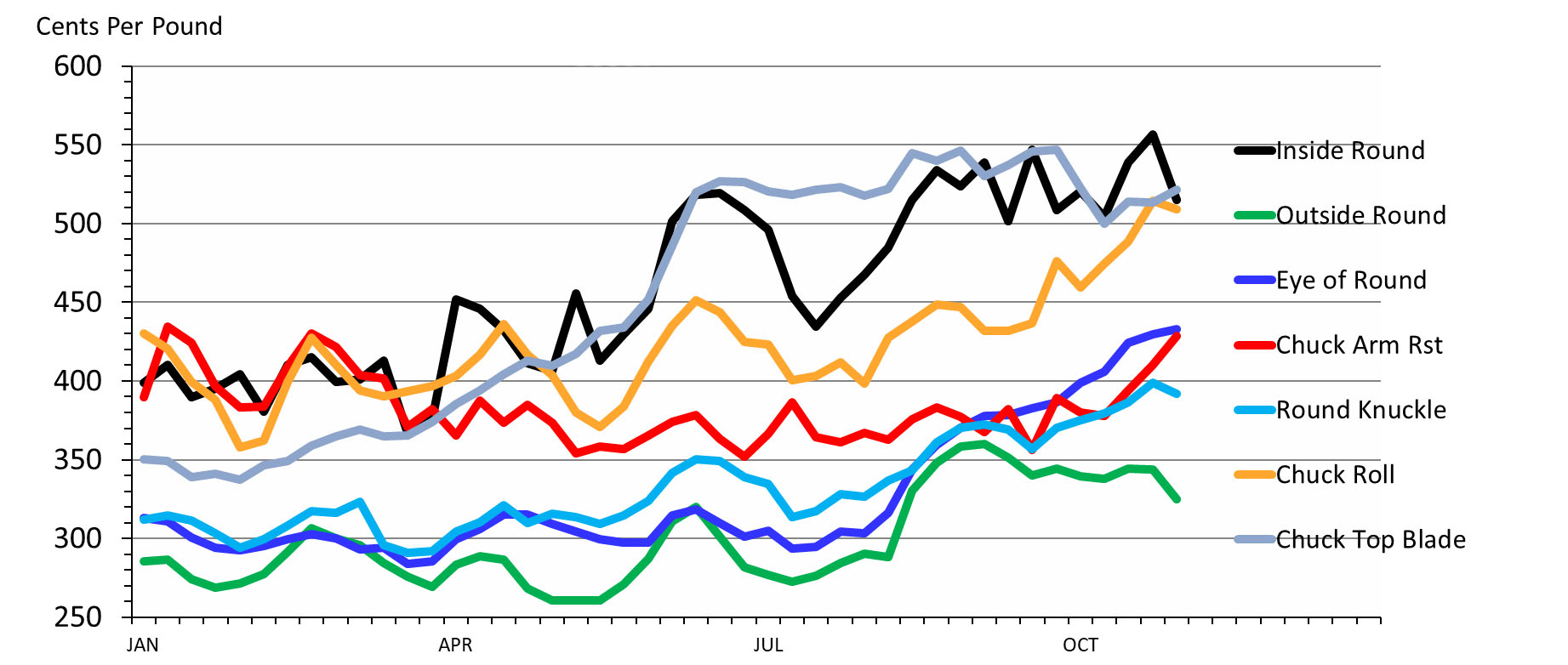Cow-Calf Corner | November 6, 2023
Demand Remains Key to High Cattle Prices
Derrell S. Peel, Oklahoma State University Extension Livestock Marketing Specialist
With ever-tightening cattle and beef supplies pushing prices higher, all eyes are on beef demand going forward. Beef demand has been remarkably robust through many shocks in recent years and continues to surprise and impress despite the nervousness of the industry to the challenges facing consumers. Post-pandemic beef demand has been exceptional since 2021. Per capita beef consumption in 2022 was 58.9 pounds, equal to 2021. Real (inflation-adjusted) retail all-fresh beef prices were record high in 2021 and just slightly lower in 2022. This compares to 2015, when real retail all-fresh prices reached the same level but with per capita beef consumption at 54.0 pounds, 8.3 percent less than the 2021-2022 level.
So far in 2023, retail all-fresh beef prices have continued to increase, especially since July, with September at $7.82/lb., a new record high monthly retail price. Retail all-fresh prices have averaged 6.6 percent higher year over year (4.0 percent higher in real dollars) in the July-September period. Since July 4, weekly Choice boxed beef prices have averaged $307.16/cwt., ranging from a low of $299.94/cwt to a high of $321.97/cwt. Choice boxed beef prices have averaged 18.4 percent higher year over year through the third quarter of the year. With beef production projected to be down more than 5.5 percent year over year, per capita beef consumption is expected to decease to 57.0 pounds this year,
Figure 1 shows weekly prices for several Choice wholesale middle cuts in 2023. Tenderloin and Ribeye, the two highest value cuts have held steady through the year and are beginning increase seasonally into the fall. Other steak items that are seasonally highest for summer grilling, including strip loins, sirloin and tri-tip have decreased from summer highs, but are generally following normal seasonal patterns.
Figure 1. Wholesale Beef Rib, Loin and Sirloin Prices
(IMPS 112A, 180, 184, 185A, 185D, 189A), 2023 Weekly
Figure 2 shows weekly Choice wholesale chuck and round products. These items all generally held steady through the first half of the year and are increasing in the second half of the year. This likely reflects both seasonal tendencies and tightening beef supplies. It is common for roast items to increase seasonally when cooler weather brings out the crock pots.
Figure 2. Wholesale Beef Chuck and Round Prices
(IMPS 114D, 114E, 116A, 171B, 171C), 2023 Weekly
There are certainly plenty of macroeconomic and geopolitical uncertainties to keep the industry nervous about beef demand. However, the increasingly high quality and consumer preferences for beef continue to be reflected in strong beef demand. These factors, combined with tightening beef supplies, will keep wholesale and retail beef prices strongly supported in the coming months.
Benefits of Proper Hay Storage
Mark Z. Johnson, Oklahoma State University Extension Beef Cattle Breeding Specialist
Proper hay storage is always important. This year, with less inventory of harvested forage and high prices, it is worth discussing some simple storage practices that can lead to less spoilage. First, one of the few upsides of drought is that very little precipitation falls on hay stored outside. Precipitation, air temperature and humidity all lead to more spoilage in big bales. Twine wrapped bales are more subject to spoilage than net wrapped. Greater bale density leads to less spoilage. That being said, keep the following in mind when considering how your hay is stored.
Storage Site and Elevated Storage
Select a site on higher ground that is not shaded and is open to air flow to enhance drying conditions. The site should be well drained to minimize moisture absorption into the bottom of bales. Ground contact leads to more bale spoilage. When practical keep bales off the ground using low cost surplus materials like old pallets, fence posts, railroad ties and tires. Another option is a six inch layer of coarse ground rock. Anything that can be done to maximize drainage and minimize moisture within and around the storage site will be beneficial.
Orientation
Bails should be stored in rows, butted end-to-end, and oriented in a north/south direction. Avoid stacking three rows of hay in a triangle shape. This formation leads to more spoilage, particularly in the two bottom rows. North/south orientation combined with at least three feet between the rows permits good sunlight penetration and airflow, allowing for faster drying. Vegetation between the rows should be mowed.
Covers and Barns
Large round bales stored outside with plastic or canvas usually sustain much less spoilage compared to unprotected bales. If barn storage is an option, this is the best method. Dry matter losses in round bales stored for up to nine months in an enclosed barn should be less than two percent.
Summary
All forages packaged in large round bales benefit from protection and proper storage practices. Producers are encouraged to consider the cost to benefit ratio of providing this protection. Factors to consider include the value of hay, projected in-storage losses, local environmental conditions, the cost of providing protection and how long the hay will be in storage before it is fed. At the very least it may be worthwhile to restack or re-orient your hay supply according to the best practices described. Further details for estimating storage losses can be found in the fact sheet referenced below.
Reference: Oklahoma State University Extension Fact Sheet: BAE-1716
Low Stress Weaning Strategies
Paul Beck, Oklahoma State University Cooperative Extension State Beef Nutrition Specialist
Weaning is a stressful time for calves. There are social stresses associated with removal from the dam and disrupting social hierarchy, physical stresses of transportation and the marketing system, and nutritional stresses of changing feed and water sources. Preconditioning on farm will take care of several of these stressors, but there is still considerable stress in normal weaning programs. There is a lot of interest in finding the best way to wean calves. Most commonly the options are:
- Abrupt weaning - which is stressful and completely changes the calf’s environment, diet and social norms.
- Nursing prevention tools – which prevent suckling but maintain contact with the dam.
- Short term separation – removal from the dam to acclimate calves to weaning pens, feed, and water sources before complete weaning.
- Fenceline weaning – placing cows and calves in adjacent pastures for 7 days allowing contact but preventing suckling.
Researchers from the OSU College of Veterinary Medicine compared these methods and found that for the 2 weeks before weaning calves fitted with a nose flap had reduced gains and weaning weight. During the 28-day preconditioning period calves that had fenceline access to dams and calves that had short term (24-hour separation) from dam gained the most, while abrupt weaned and calves fitted with a nose flap pre-weaning gained the least. The performance of calves over the entire duration of the experiment, from 2 weeks pre-weaning to 28 days post-weaning was only 0.85 lb/day for the Abrupt weaned calves, 1.1 lb/day for the calves fitted with the nose flap, 1.3 lbs/day for short-term separation calves, and 1.5 lbs per day for the fenceline weaned calves.
The reduced performance by the calves fitted with the nose flap can be explained by research that the nose flap decreased activities like grazing, walking, ruminating, and playing, while sucking attempts and time spent near the dam increase. Additionally, blood cortisol levels (an indicator or stress) increase when the nose flap is present. Calves in the fenceline weaning system only spent 2 days with the majority of time spent within 15 feet of the fence and time spent near the fence reduced dramatically over the next 3 days. Fenceline weaning was shown to reduce indicators of stress and increase grazing and feeding behaviors during the weaning process. The apparent success of the short-term separation treatment shows the benefits of familiarization of calves to supplements and facilities prior to weaning.
Research from Louisiana showed little carryover of the benefit of fenceline weaning over the entirety of production, but calves preconditioned for only 21 days gained less during finishing and were 54 pounds lighter at harvest than calves preconditioned for 42 days, regardless if fenceline or abrupt weaning were used.
Low stress weaning techniques can pay dividends to producers adding value through a preconditioning program.


